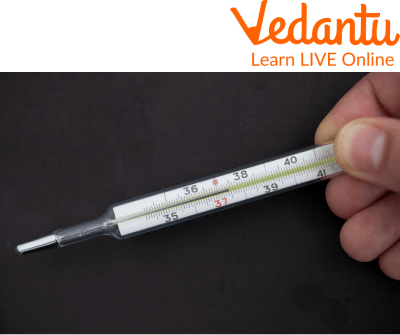




Overview of Mercury
Mercury is a chemical element which has an atomic number of 80. It is the only metal that is liquid at standard conditions. This liquid has a density close to that of water and a density greater than most other metals. It behaves similarly to a metal, but it reacts with water solution as if it were acid. At room temperature mercury has the highest thermal conductivity of any elemental solid, over four times the thermal conductivity of copper and nine times that of silver or gold.
In this article, we will study about the mercury and uses of mercury in the glass thermometers in detail.
What is Mercury?
Mercury is a shiny liquid that is colourless as well as transparent. As one may observe when a clean glass thermometer filled with mercury is held so that sunlight shines through, mercury has an inner glow. Mercury's liquid form has no memory of its previous shape, so it tends to flow when put in a container. This means that mercury is unshaped by dropping into a container, so it cannot be easily measured using what are called refractometers, but can be determined by dividing the volume at standard temperature and pressure by the density. The measurement used is known as a specific gravity. Now, let’s learn more about this important element.
Uses of Mercury in Everyday life

Use of Mercury to Test Diseases
Mercury is known for many uses, including:
As a chemical element and in the production of mercury-based products, such as thermometers
For its use in electroplating and silvering (see tinning)
As a fungicide or disinfectant
A contact lens disinfectant or preservative
As a pressurant or desiccant and as a dental amalgam alloy
In electrical contacts and switches which require high temperature operation with low corrosion
In India, it is used in the production of mercury lamps, and also used in military equipment.
As an additive to preservatives in concrete and plaster
As an ingredient to rubber compounds, detergents, dyes, adhesives, insulation compounds, paints
In photography, to make the image on film sensitive to light
Your ears can be used as an example to explain this phenomenon because they contain liquid mercury. When it is cold, the liquid inside your ears contracts, causing your ear canals to narrow.
Why is Mercury Used in Thermometer?
The thermometer is an instrument used to measure the temperature of objects. It indicates the temperature in degrees Celsius and has a glass tube filled with water or alcohol through which heat from objects is transferred to the liquid. The term for the instrument itself stems from the Greek word thermē meaning heat. Thermometers are one of those inventions that you don't really think about too often, but when you do, it's pretty disturbing.

Mercury Thermometer
Thermometers use mercury under pressure to measure the temperature of things—or in this case, the air around us. Yeah, something as important as how hot or cold we are involves dipping a needle into something toxic and using it to judge what is going on with our bodies!
Mercury's liquid property allows thermometers to work because they can expand or shrink depending on temperature. That gives them a range of 0 to 100 degrees Celsius. And the fact that mercury is poisonous allows doctors and scientists to more easily figure out if a person is sick. In this way, mercury plays an important role in our daily lives in ways we don't even realise. So next time you're taking your temperature, remember that mercury is the reason it's possible for you to know how hot or cold you are!
What is Mercury Thermometer?
A mercury thermometer is a thermometer that uses mercury to determine the temperature. It's filled with liquid mercury and an upward-pointing quill inside a glass tube. The density of the liquid metal causes it to collect at the tube's higher end when the mercury column in the tube is inverted.
The quill, thin and hollow, has its upper end in contact with air, so it’s buoyant and will rise or fall due to thermal expansion, which causes changes in volume of metal at either end. Dividing the volume of the quill by any glass tube's volume leads to an accurate estimation of temperature. The mercury level is adjusted (that is, raised or lowered) to make tall columns in glass tubes, which are about measurement distances apart. The level must also be calibrated with a liquid such as alcohol, air or water that is known to be of a known density at a known temperature.
Uses of Mercury in Glass Thermometer

Mercury in Glass Thermometer
The uses of mercury in glass thermometer include:
A glass thermometer is a type of thermometer that uses a column of liquid and mercury to show changing temperature.
Mercury thermometers are the oldest kind, dating back to the 1500s, and have been used for medical purposes since 1857.
It is a liquid in the tube that carries heat from one place to another.
Summary
In this article, we learned that mercury in a glass thermometer is there to provide an accurate measurement of the temperature. The mercury in a glass thermometer provides an accurate measurement of the temperature by expanding and contracting with temperature changes. We also learned that it is important for this liquid metal to surround the bulbous end where the temperature is measured because it can move much more easily than any other metal. This allows for quick response time between reading and changing, which is essential when taking medical or industrial measurements. We hope you enjoyed reading this article, in case of any other doubts, feel free to ask in the comments.
FAQs on Uses of Mercury in Thermometers
1. What is special about mercury?
It is the only element in the periodic table which is in liquid form at standard temperature and pressure conditions.
2. What is the other name of mercury element?
The other name of the mercury element is quicksilver.
3. Is mercury toxic?
Depending on the type and amount long term exposure to mercury can damage liver, kidneys and nervous system.
4. Mercury thermometers can be used to measure temperature upto what degree?
Mercury thermometer can be used to measure temperature up to 357 degree celsius.









